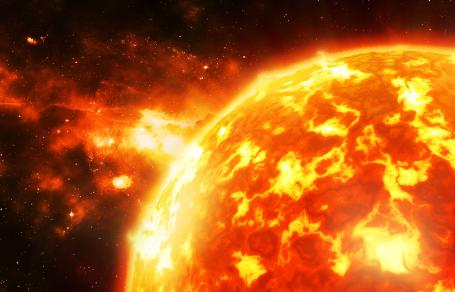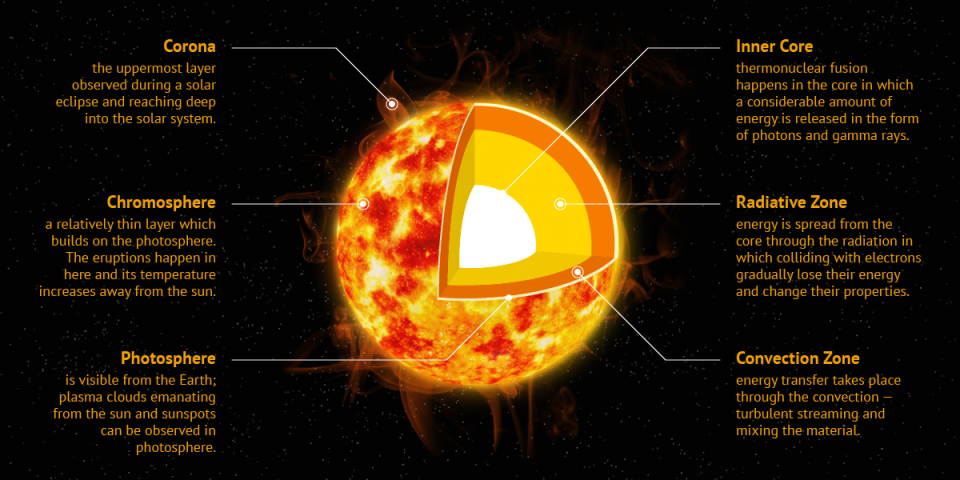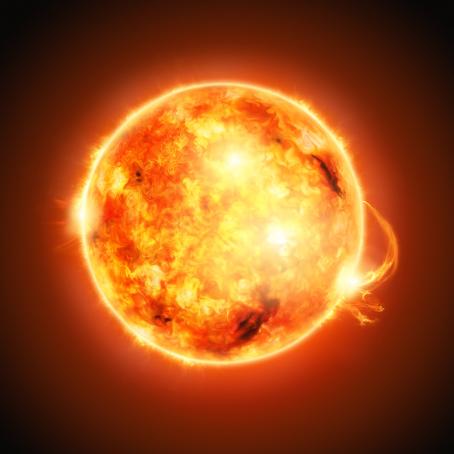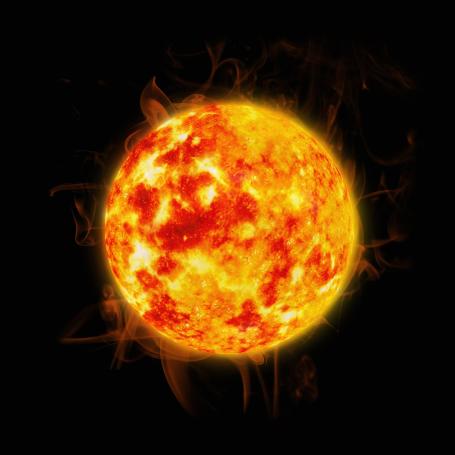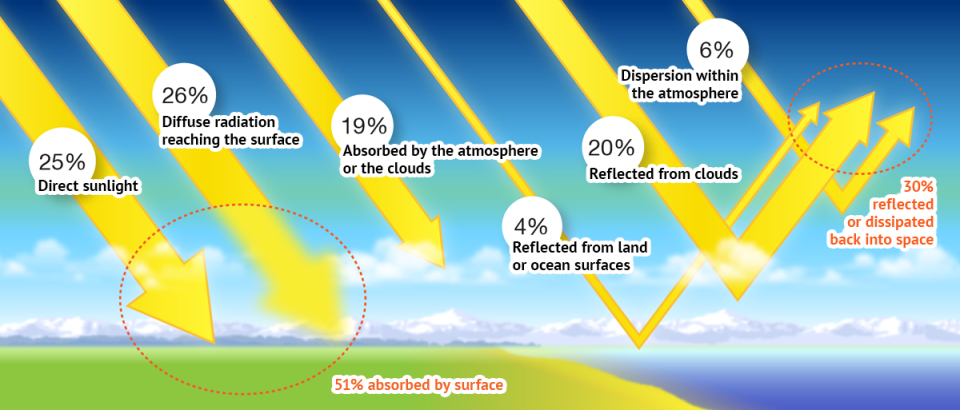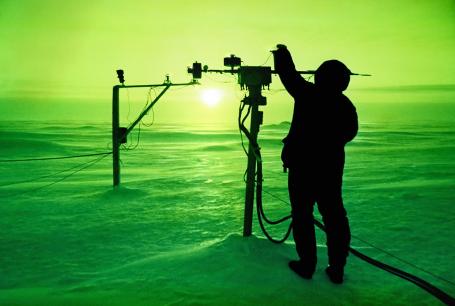
Solar Rays Energy
7 min read
The Sun
Protuberances can be observed on the surface of the Sun. These are enormous clouds of plasma ejected into the surroundings.
The Sun’s energy is released in a thermonuclear reaction that is going on in the core of the star at temperatures as high as 14 million °C. A part of the solar radiation that falls on the Earth’s surface can be utilized in solar installations. These work on the principle of heat absorption or they directly convert solar radiation into electricity.
| Distance from the Earth | app. 150 million km (1 AU) |
| Diameter | 1,392,000 km (109 × Earth) |
| Volume | 1.41 × 10¹⁸ km³ (1,300,000 × Earth) |
| Surface temperature | 5,780 K |
| Corona temperature | 2 million K |
| Power output | 3.8 × 10²⁴ kW |
The Sun is the largest body in our Solar System. It is so big that the combined mass of all the remaining objects in the system is only 0.2% of the mass of the Sun. The Sun is in fact one huge, hot plasma ball with a density a little higher than water. Thermonuclear reactions, which are continually running inside the Sun, release enormous amounts of energy which is continuously radiated into the Sun’s environment. Only about a 45 billionths of this energy reaches the Earth but it is still enough to maintain an equilibrium and energy supply to almost all processes on the Earth.
The Sun has several different layers with varying temperatures, pressures and chemical compositions. At the centre of the Sun, there is the core in which the thermonuclear reaction is running. Four protons combine into a helium core and an alpha particle, releasing tremendous amounts of energy in the form of photons and gamma radiation. In the 200 thousand km thick convective zone, the energy is not transmitted through radiation anymore but by convection, i.e. through turbulent streaming and mixing of material. The next layer, the photosphere, is the first that is visible from the Earth. Sunspots and protuberances, bright plasma clouds emanating from the Sun, can be observed in the photosphere. The uppermost layer is the corona which can be observed during a solar eclipse. The corona reaches out deep into our Solar System.
The Sun radiates enormous amounts of energy into its surroundings, as a result of the thermonuclear reaction within.
Thanks to its extreme mass and slow rotation, the Sun is an almost perfect sphere. Its equatorial and polar diameters differ only by 10 kilometers.
The thermonuclear reaction on the Sun consumes an estimated 700 million tonnes of hydrogen, producing 695 million tonnes of helium, every second. The missing 5 million tonnes are transformed into energy.
The life-giving Sun has existed for approximately 4.6 billion years. During its existence, it has burnt about a half of its hydrogen reserves. Its life expectancy is another 5 to 7 billion years.
Sunlight travels 8 minutes and 19 seconds from the Sun to the Earth. The next nearest star is the Proxima Centauri, the light from which takes 4.22 years to reach the Earth.
Solar Radiation
Solar energy falls on the Earth in the form of solar radiation. About 30% of the falling radiation is reflected back to space by the atmosphere, the clouds and the Earth’s surface. A portion of the radiation, about 19%, is absorbed by the atmosphere and about half of it reaches the Earth’s surface, where it is absorbed by landmasses and oceans. Absorption and reflection of the radiation by the Earth has to be balanced.
About one half of the sunlight, crossing paths with our planet, actually reaches the Earth’s surface.
If it were not, the Earth would get cooler or hotter. It follows from the above mentioned that approximately the same amount of energy that is absorbed by the Earth and its atmosphere is radiated from the Earth into space. The energy transfer between the Earth’s surface and the upper layers of the atmosphere is helped by the physical processes in the atmosphere, such as circulation, evaporation and condensation. The atmosphere radiates about 64% of the amount of the Sun’s energy falling on the Earth. Another 6% is radiated directly from the Earth’s surface.
As the Sun’s radiation passes through the atmosphere, a part of it is filtered away. The atmosphere only lets through visible light with wavelengths between 400 and 750 nm and a part of the ultraviolet and infrared light. The Sun’s radiation reaches the Earth’s surface either directly or as diffuse sky radiation which is light dispersed by particles in the atmosphere. The ratio between direct and diffuse radiation primarily depends on the amount of pollutants present in the atmosphere. The amount of energy that falls on a unit of an area that is perpendicular to the Sun’s rays in a unit of time is called the intensity of solar radiation.
The highest intensity of solar radiation is reached at the wavelength of 500 nm, i.e. yellow light.
The dispersion of sunlight illuminates the sky during the day. If it were not for dispersion, the sky would be dark during the day as it is at night, with the exception of the sharp bright disc of the Sun.
The Solar Constant
The Solar Constant is the amount of solar energy passing through a 1 m² area that is perpendicular to the direction of the radiation in one second at a distance of one astronomical unit (the mean distance of the Earth from the Sun). Its value is 1.367 W/m² and it fluctuates within the order of one tenths of a per cent depending on the activity of the Sun and the Sun’s eleven year cycle. The average yearly power available on the Earth’s surface then is 170 W/m². It is the highest on the equator and the lowest on the poles but since the equatorial regions are often shrouded by clouds, the ideal region for developing solar power is between 15° and 40° of latitude. 7,500 times the yearly energy consumption of humanity (450 EJ in 2010) falls on the Earth’s surface in the form of solar radiation.



